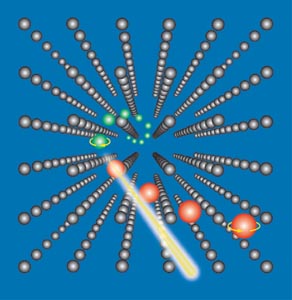
New investigations being made into the behaviour of charged particle beams as they pass through crystals suggest that the very high electric fields inside these crystals could be used to orient (polarize) the spins of the particles.
The spin of an electron can be imagined as equivalent to a tiny current-carrying coil. This coil will induce a neighbouring magnetic field, which will interact with any other electromagnetic field.
In the early 1960s it was seen that the interaction of this intrinsic electron magnetism with the magnetic field in a circular accelerator could be used to polarize circulating electrons. This is now routinely used to polarize beams of electrons in storage rings. However, this polarization takes hours to achieve because the fields are very weak.
During the 1990s the NA43 collaboration at CERN made an in-depth study of what happens when a high-energy beam passes through various crystal structures. When such a beam penetrates a crystal, it “sees” a strong coherent electric field due to the nuclear constituents. Moreover, if the charged particles are moving at relativistic speeds, the apparent fields are even higher, attainingthe so-called critical field, 1016V/cm. Under these conditions, the electrons align their spin in the field in about the same time as it takes to traverse the crystal, 1 ps, instead of several hours.
Under these conditions the photons emitted in the individual electron spin-flips can also be studied. Such effects could be of interest for planned high-energy linear electron-positron colliders, such as CERN’s CLIC, and they are probably also found at the surface of neutron stars, where the fields are of a strength comparable to the critical field.
Another well-known crystal-beam effect is “channelling”, which is when the charged particle beam is steered through the crystal by its interior electromagnetic fields. Using a bent crystal provides a more economical way of steering a beam than conventional large magnets. Channelling in bent crystals is routinely used in experiments, notably the NA48 CP-violation study at CERN.





